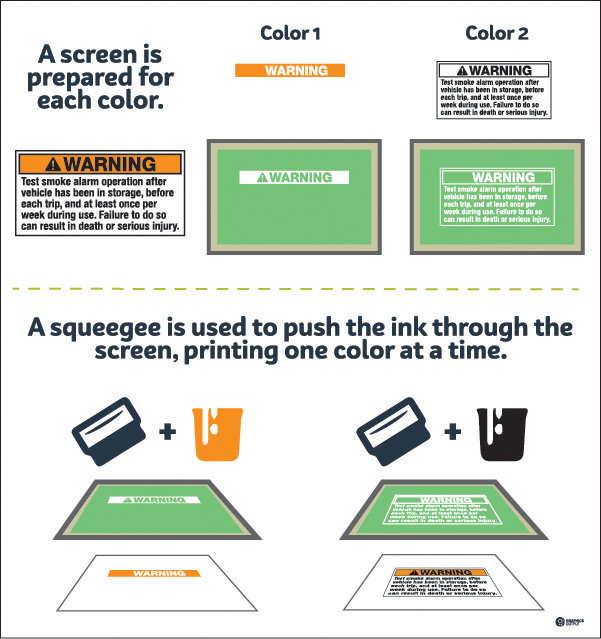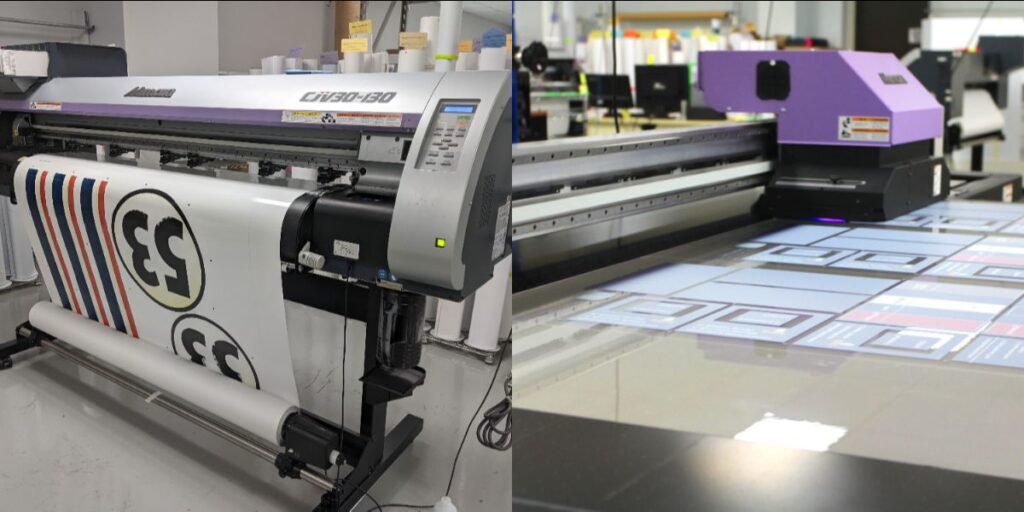In the world of printing, two predominant methods stand out for their distinct approaches and applications: screen printing and digital printing. Each method brings unique advantages and considerations, making them suitable for different types of projects, industries, and desired outcomes. Understanding their differences is crucial for making informed decisions in various printing scenarios.
So, let’s explore both methods.
What is Screen Printing?
Screen printing, also known as silk screening, is a traditional printing technique where ink is pushed through a stencil (or screen) onto a surface. Each color in the design requires a separate screen, and the ink is applied layer by layer. This method is known for producing vibrant, long-lasting colors and is ideal for bulk printing on materials like fabric, paper, and plastic. It’s commonly used for t-shirts, posters, and signs, especially when solid, bold colors are needed. Screen printing is cost-effective for large runs but requires more setup time compared to other methods.

Key Features:
- Color Vibrancy: Produces vibrant and opaque colors, especially effective on darker substrates.
- Durability: Ensures longevity of prints, making it suitable for products subjected to repeated washing or outdoor exposure.
- Cost Efficiency for Bulk Orders: Economical for large production runs once setup costs are amortized over a high volume of prints.
Applications:
- Textiles: Apparel, bags, and accessories where durability and color intensity are paramount.
- Industrial Printing: Circuit boards, signage, and specialized applications requiring precise ink deposition.
- Art Prints and Posters: Limited edition prints and artwork requiring vivid colors and fine details.
What is Digital Printing?
Digital printing is a modern printing method that involves transferring digital images directly onto various materials without the need for plates or screens. It works similarly to a home inkjet printer but on a larger, more advanced scale. Using digital files, such as PDFs or image formats, the printer applies ink or toner directly to the surface of the material.
This method is highly versatile, allowing for full-color, detailed prints, and is ideal for smaller print runs, customized items, or projects with intricate designs. Digital printing offers quick turnaround times and is cost-effective for low to medium-volume printing.

Key Features:
- Versatility: Digital printing excels in handling intricate designs, photographs, and multicolor images with high precision.
- Cost-Effectiveness: Ideal for small to medium print runs due to minimal setup costs and no requirement for separate screens or plates.
- Speed and Efficiency: Offers quick turnaround times and allows for on-demand printing, making it suitable for rapid production cycles.
Applications:
- Apparel: T-shirts, hoodies, and other garments with complex or detailed designs.
- Marketing Materials: Brochures, posters, banners, and promotional items requiring variable data printing.
- Personalization: Customized products such as personalized gifts, event merchandise, and individualized marketing campaigns.
Well, apart from that, let’s talk about the questions that came to mind while choosing the right method.
Screen Printing and Digital Printing.
Price Comparison
Depending on the quantity of prints you require, you might be better off using one of the methods over the other. For example, if you’re after a small number of copies, then screen printing probably isn’t the best way to go as the initial setup can be expensive. However, the more prints you need, the cheaper this process will work out in the long run as once the screen printing machine has been calibrated, there’s no need to do it again. This setup is often charged as a one-off fee – the origination fee.
Digital, on the other hand, works out a lot cheaper for smaller quantities as you don’t have to pay the origination fee.
The price per print can also depend on the number of colours you want to use. Black and white digital printing is cheaper, but there’s no difference if you decide you want one colour or one hundred. An additional screen is required for each new colour with screen printing which means any additional colours will cost you.
Age of Screen Printing Process
Screen printing’s original roots go back to Egyptian times with stencilling and then later in China (900 A.D.) when they first forced ink through silk fabric to create images. It was then that ancient artists first stretched silk fabric across a frame and poured hot beeswax into it. Although, it wasn’t until the 1880’s that screen printing took off as a commercial process for decorating fabric.
Age of Digital Printing Process
The digital printing process was introduced relatively recently with the first digital printing presses being introduced in the early 1990’s. Digital printing processes have evolved a lot in the meantime to the point where batches of digital prints can be published in a matter of seconds.
What are the Benefits and Cons of Screen Printing and Digital Printing?
People looking for printing advice very often ask about the differences between screen printing and digital printing, so let’s discuss the benefits and cons of these two print methods to help you make the decision on the best way forward for your specific print job.
Benefits of Screen Printing.
- The higher quality output than digital prints
- More durable for prints that are needed over the long term
- Can be used on a variety of different print materials, including glass, wood, textiles, signs, banners, electronics, and much more
- It’s easy to print on specified areas of the print material
Cons of Screen Printing.
- More limited colour ranges are available
- The amount of ink used can make the design look as if it is raised from the print material
- It cannot be customised in the manner of digital printing
Benefits of Digital Printing.
- Low cost set up and speed of turnaround
- Easy to print in a range of different colours
- Transfer photographic images accurately
- Best for one-off or short print runs
- Prints can be customised in a variety of ways
- Designs sit flat on the print material and do not bulge out from the surface
Cons of Digital Printing.
- The range of printable fabrics is more limited than with screen printing
- The print is not so durable
- The colour white cannot usually be reproduced within the print
- Due to fixed pricing, bulk printing does not offer scaled cost reductions
Both screen printing and digital printing offer unique advantages that cater to different printing needs. Digital printing is prized for its versatility and efficiency in handling complex designs and smaller print runs, while screen printing stands out for its vibrant colors, durability, and cost-effectiveness in large-scale production. By understanding these differences, businesses and individuals can choose the printing method that best aligns with their project requirements, budget constraints, and desired outcomes.
In essence, whether aiming for intricate designs on custom apparel or vibrant posters for marketing campaigns, the choice between screen printing and digital printing hinges on balancing factors of design complexity, volume, budget, and desired print characteristics.